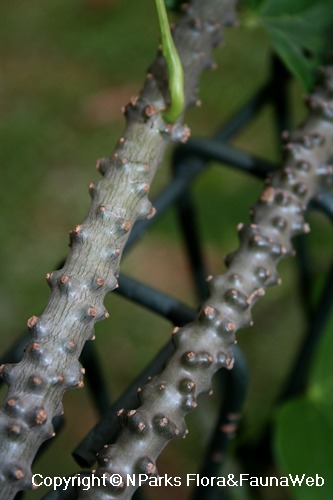.jpg)
Back
Tinospora crispa (L.) Miers ex Hook. f. & Thomson
| Family Name: | Menispermaceae |
| Synonyms: | Tinospora nudiflora, Tinospora rumphii, Menispermum crispum |
| Common Name: | Petawali, Makabuhai, Liane-quinine |
Tinospora crispa, also known as Petawali is a climbing vine from tropical and subtropical regions, that has attractive heart-shaped leaves and warty stems. This plant is used in traditional medicines to treat many illnesses for its pharmacological activities.
Name
Classifications and Characteristics
| Plant Division | Angiosperms (Flowering Seed Plants) (Dicotyledon) |
|---|---|
| Plant Growth Form | Climber, Shrub |
| Lifespan (in Singapore) | Perennial |
| Mode of Nutrition | Autotrophic |
| Maximum Height | 4 m to 10 m |
Biogeography
| Native Distribution | Southern China, Indochina, India, Sri Lanka, Philippines, Malaysia, Indonesia |
|---|---|
| Native Habitat | Terrestrial (Primary Rainforest, Secondary Rainforest, Monsoon Forest, Temperate Forest) |
| Preferred Climate Zone | Tropical, Sub-Tropical / Monsoonal, Temperate |
| Local Conservation Status | Non-native (Spontaneous (Casual)) |
Description and Ethnobotany
| Growth Form | A woody vine with attractive heart-shaped leaves, and fleshy stems with numerous warty protuberances known as tubercles. |
|---|---|
| Foliage | The leaves are large, heart-shaped measuring about 6–12 cm long and 7–12 cm wide. Petioles are glabrous and 5–15 cm long. Leaf blade is slightly fleshy, and smooth, with entire to wavy margin. |
| Stems | The younger stems are slightly fleshy and smooth, while the mature stems are thick and fleshy with blunt tubercles. |
| Flowers | Flowers are small, yellowish green. |
| Fruit | Fruit is 7-8 mm long. |
| Cultivation | This plant tolerates a wide range of soils, and grows especially well in secondary forests. Propagated by stem cuttings, which remain viable for around 1 year if stored in a sealed container. Popularly planted as a herbal plant. |
| Ethnobotanical Uses | Edible Plant Parts : Edible Fruits Food (Herb or Spice) Medicinal: Malays and Filipinos consider it a universal cure-all -- the Tagalog name 'Makabuhai' means 'to give life'. Parts of stems and powdered extracts commonly sold in traditional Chinese medical halls. Others: Stem decotions used to purify blood, as well as to treat stomachache, fever, worms, gonorrhoea and skin conditions like itch and ulcers. Stem and root extracts used to relieve malaria, high blood pressure, diabetes and bacterial abscesses. Powdered stem believed to stimulate appetite in horses and cattle, and used to fatten up livestock. |
Landscaping Features
| Desirable Plant Features | Ornamental Foliage, Fragrant (Flowers) (Day), Ornamental Trunk, Ornamental Stems |
|---|---|
| Landscape Uses | Vertical Greenery / Green Wall |
| Thematic Landscaping | Economic Garden |
| Plant & Rootzone Preference or Tolerance Remarks | Plant tolerates a wide range of soils. |
Plant Care and Propagation
| Light Preference | Full Sun |
|---|---|
| Water Preference | Moderate Water |
| Plant Growth Rate | Fast |
| Rootzone Tolerance | Fertile Loamy Soils, Poor Infertile Soils |
| Maintenance Requirements | Moderate |
| Propagation Method | Stem Cutting |
| Propagation Method Remarks | Cuttings remain viable for around a year, if stored in sealed box. |
Foliar
| Foliage Retention | Deciduous |
|---|---|
| Mature Foliage Colour(s) | Green |
| Mature Foliage Texture(s) | Smooth, Glossy / Shiny, Raised / Sunken Veins |
| Foliar Type | Simple / Unifoliate |
| Foliar Arrangement Along Stem | Spiral |
| Foliar Shape(s) | Non-Palm Foliage (Ovate) |
| Foliar Venation | Pinnate / Net |
| Foliar Margin | Entire - Wavy / Undulate |
| Foliar Apex - Tip | Cuspidate |
| Foliar Base | Cordate |
| Typical Foliar Area | Mesophyll ( 45cm2 - 182.25 cm2 ) |
Non - Foliar and Storage
| Bark Colour(s) | Green |
|---|---|
| Stem Type & Modification | Woody |
| Root Type | Underground (Fibrous Root), Aboveground (Aerial Root) |
| Mature Bark Texture Remarks | Stems have numerous protuberances known as tubercles. |
Floral (Angiosperm)
| Flower & Plant Sexuality | Bisexual Flowers |
| Flower Colour(s) | Green |
|---|---|
| Flowering Habit | Polycarpic |
Fruit, Seed and Spore
| Mature Fruit Colour(s) | Orange |
|---|---|
| Fruit Classification | Simple Fruit |
References
| References | https://www.frontiersin.org/articles/10.3389/fphar.2016.00059/full |
|---|
Image Repository
Others
| Master ID | 18614 |
|---|---|
| Species ID | 3346 |
| Flora Disclaimer | The information in this website has been compiled from reliable sources, such as reference works on medicinal plants. It is not a substitute for medical advice or treatment and NParks does not purport to provide any medical advice. Readers should always consult his/her physician before using or consuming a plant for medicinal purposes. |

.jpg)




